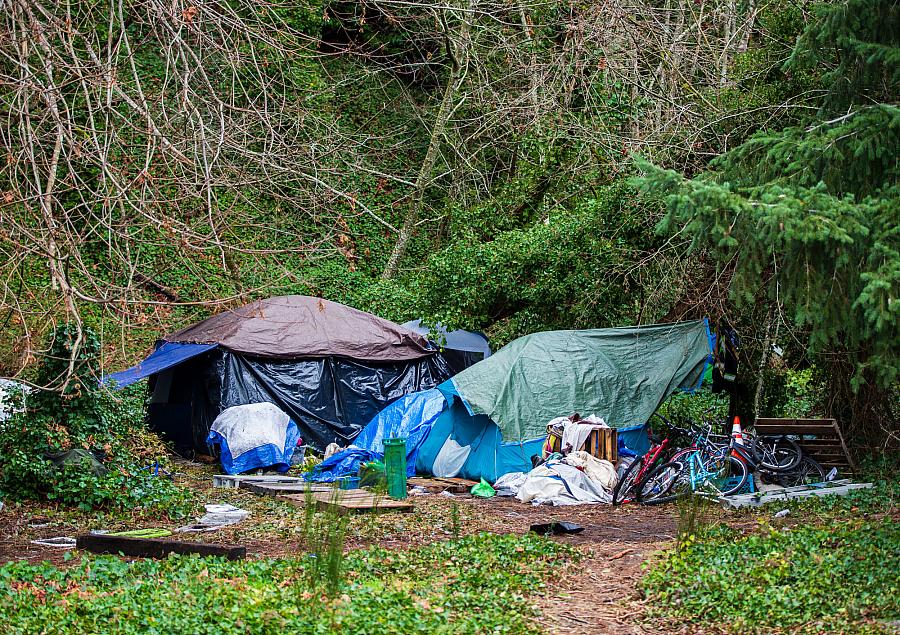How a podcast brought Washington state’s homeless problem home for audiences

A homeless encampment in Olympia, Wash. (Credit: Parker Miles Blohm / KNKX Public Radio)
Around Christmas time, Jessica lost her housing in Olympia, Washington, after her downstairs neighbors complained about her nephew running around one too many times. Soon after that, her uncle committed suicide, and her ex-husband kidnapped her daughter from school. “I lost my housing and they wouldn’t let me appeal it, so I’ve been living on the streets ever since,” Jessica told reporter Will James of KNKX Public Radio.
Homeless advocates and journalists often note that we’re all one catastrophe away from living on the streets. While that sentiment may make the issue of homelessness seem more relevant to middle-class audiences, it glosses over the myriad of factors that work together to make certain groups, such as black and indigenous people, more at risk of losing their housing.
“In many cases, it was a combination of three or four of these things,” James recently told reporters at the 2020 California Fellowship. “And these are the forces in someone’s life that make that final fall into homelessness, and make that final catastrophe more devastating when it happens.”
James explained why stories about homeless are messy and complicated, and how our reporting should reflect that. For the past four years, his reporting has focused on the worsening homelessness in Washington state communities. In collaboration with reporters from the Seattle Times, James launched the podcast “Outsiders,” which uses the state capitol of Olympia as a microcosm to explore the issue of homelessness and efforts to combat it.
From the outset of the project, the team aimed to “collapse the distance” between their audience and the community’s ubiquitous homeless issue. “It was in their lives constantly. It was so visible and impossible to ignore,” said James. “And yet, there was this distance from it.”
Daily reporting on homelessness, combined with secondhand information from politicians and experts, left residents with an incomplete picture of the homeless experience. “We wanted to try to use audio journalism, which has the ability to create intimacy and get people to feel like they know each other, to try to collapse some of the distance and ultimately give people an image of homelessness in their heads that makes sense,” explained James.
In order to fully capture the story of homelessness in our communities, James shared these key insights from the project.
1) Meet people where they’re at.
James encouraged journalists reporting on homelessness to give up the ideal of finding interviewees who can tell a story in a clear and succinct way. “The reality of reporting on homelessness is you don’t have the luxury of building stories around good talkers. You have to meet people where they’re at.”
2) Plan to spend time with your subjects.
“These stories are complicated and they don’t always unfold in chronological order,” said James. One interview is almost never going to be enough. Because it can be hard to get people from vulnerable communities to recount events in detail, spending more time with subjects may allow you to actually be there when important things happen.
3) Be honest, but give context.
“Be honest about what you’re seeing and hearing, but do your best to contextualize it,” said James. Give your subjects a chance to explain themselves and their actions.
4) Assume rationality.
“Assume people are rational actors and assume people have a reason for doing things,” says James. One of the most poignant moments James recounted was his interview with a homeless woman named Sarah, who shared her story of drug use. The victim of multiple sexual assaults, Sarah takes meth to be able to stay up and protect herself all night. James pointed out that many of the chaotic behaviors you might spot around homeless encampments are both symptoms of and responses to the experience of homelessness.
5) Lean into complexity.
The factors and events that lead a person to homelessness are often complicated and messy. They’re also essential to telling the true story of homelessness in a community. “It’s possible to humanize someone in their full complexity,” said James. “Their criminal records, their drug use, the wrinkles in their lives. It’s something we need to get better at as health journalists: We can’t whitewash the messiness in their lives.”
6) Avoid the “one catastrophe” story.
Stories on homelessness often push the narrative that any one of us are one big event away from becoming homeless. While it’s true that we’re all susceptible to homelessness, it’s important for journalists to explore the societal factors and background stories that influence a person’s risk, such as childhood trauma, race, and access to support systems.
Listen to Will James’ “Outsiders” podcast series here.

